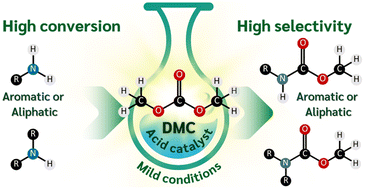Acid-catalysed reactions of amines with dimethyl carbonate†
Abstract
Highly effective acid-catalysed reactions of amines with dimethyl carbonate (DMC) have been conducted with significant yields and selectivity of carboxymethylation or methylation products. Lewis acids (FeCl3, ZnCl2, and AlCl3·6H2O), Brønsted acids (PTSA, acetic, and formic acids), and acids supported on silica (silica sulfuric and silica perchlorate) resulted in carboxymethylation of primary aliphatic amines with high conversions. It was found that the Lewis acid FeCl3 also promoted carboxymethylation of primary aromatic amines and secondary amines. At both 90 °C or an elevated temperature of 150 °C under pressure, AlCl3·6H2O demonstrated highly selective monomethylation of aromatic amines. In addition, both silica sulfuric acid and silica perchlorate at 90 °C exhibited no conversion for secondary amines but enhanced carboxymethylation with high conversions of 80.7–87.5% and selectivity of >99.00% at 150 °C in a pressure reactor. At 1.0 equivalent, both promoted excellent conversion and selectivity of primary aliphatic amines at 90 °C. In addition, they were easily recovered and reused for at least four additional reactions without significant loss of efficiency with consistent conversions and selectivity. Green metrics evaluation for the silica sulfuric acid-catalysed reaction highlighted the sustainability features of the process. Silica-supported catalysts are highly stable, making them ideal alternative catalysts for the methylation and carbonylation of various amines with DMC. Acid-catalysed DMC reactions of amines may expand the substrate scope and offer new opportunities for developing sustainable organic synthetic methodologies.



 Please wait while we load your content...
Please wait while we load your content...